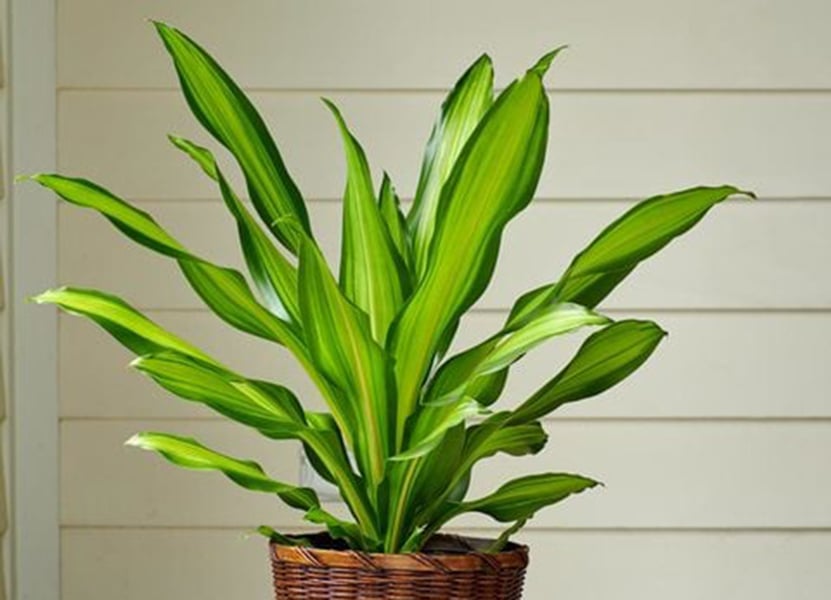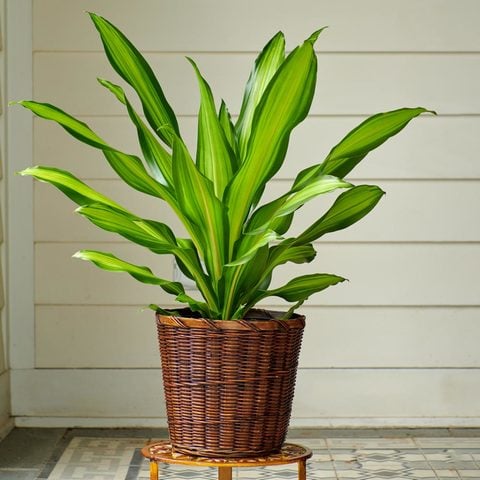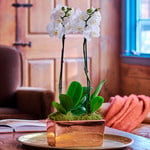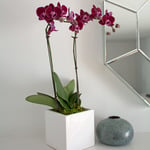Corn Plant Care

Dracaena Pronunciation: druh·see·nuh
Dracaena fragrans is an evergreen tree frequently grown indoors as a houseplant. Renowned for its attractive foliage that resembles that of sweet corn, Dracaena fragrans is commonly referred to as “Corn Plant”. They are generally considered easy care, with relatively low light and water needs.
Dracaena Corn Plants are commonly grown in homes and offices where their large stature makes for an attractive focal point. Mature Dracaena can reach over 6’ feet in height with leaves spanning up to 2’ long, though they can be trimmed to fit smaller spaces. They are also renowned for their air purifying capabilities.
In their native habitat in tropical regions across Africa, Dracaena fragrans are known for their fragrant flowers and beautiful foliage. While flowering is much less common when grown as a houseplant, mature Dracaena may flower indoors under the correct growing conditions which mimic their natural habitat. Ideal conditions include: indirect light, moderate temperatures, and humid atmosphere.
They can tolerate some neglect, including low light levels and infrequent watering, though the plant may become unattractive as a result. Corn Plants are most easily damaged by excessive water and/or sunlight.
Light
Dracaena prefer bright, indirect light. Consider placing your houseplant near an east-facing window. For south- or west-facing windows, filter bright sunlight through a sheer curtain. Dracaena can tolerate low light levels, though leaves may lose some of their attractive variegation if light levels are too low. If Corn Plants receive too much direct light, their leaves will become scorched and brown.
Watering
Corn Plants thrive in soil that is moist, but never soggy. During active growth periods in the spring and summer months, water Corn Plants whenever the top 1” of soil feels dry. During fall and winter months, reduce watering to whenever the top 2” of soil become dry. Dracaena fragrans can develop root rot if they receive too much water, so always check soil moisture before watering.
Soil
Most well-draining household potting mixes are suitable for Corn Plants. Standing water can quickly damage or kill a Corn Plant, so drainage is imperative. Select a mixture that contains perlite and/or vermiculite and ensure the planter or pot has adequate drainage holes.
Fertilizer
During active growth periods in the spring and summer, fertilize monthly with a liquid household plant fertilizer diluted to one-half strength. Do not fertilize during fall and winter months.
Temperature
Corn plants can be grown outdoors year-round in USDA Hardiness Zones 11 and 12. Otherwise, they can be grown outdoors in containers during warm summer months but should be brought indoors before temperatures drop below 60ºF.
Most indoor temperatures are suitable for Dracaena. Plants may be damaged by drafts so keep them away from windows or air vents. If indoor humidity levels are low, consider using a humidifier or misting your Corn Plant regularly to help maintain humidity levels around the plant.
Pruning
Older leaves along the bottom of the plant will become yellow over time. Use clean, sharp pruning shears to remove any yellowing leaves.
The top of the Corn Plant can be pruned to cap the plant’s height, if desired. Trim the top of the stem (“cane”) with sharp, clean shears at the preferred height. Wherever you cut will generate new leaves within a few weeks. You can use any part of the cane that is removed to propagate new Corn Plants.
Repotting
Dracaena plants are slow to grow, so they do not need frequent repotting. If the plant becomes rootbound, move to a new pot that is about 2–3” larger, and fill with fresh potting mix. Repotting is best done in the spring or summer when Corn Plants are in an active growth stage.
Pests/Diseases
Dracaena Corn Plants are susceptible to most common household plant pests and diseases. Check underneath leaves and along the trunk regularly for signs of pests as early treatment is the most effective. If you notice a white cottony mass, that can indicate mealybugs or soft scale. White, tan, or dark brown bugs attached to plant stalks and stems may be scale, which can pierce the plant and suck juices from it. If there are small brown or yellow spots on the leaves, sometimes accompanied by fine webs, this can be a sign of spider mites. Masses of miniscule bugs swarming around the plant may be aphids.
Most common pests can be treated with a steady stream of water. Rinse the affected area with a spray bottle or by holding it under running water. Allow the area to dry completely and check regularly to ensure the pests have not returned. If water is not effective, consider using a gentle household insecticide, such as neem oil.
If Corn Plants receive too much water and/or inadequate drainage, they may develop root rot. If you notice a foul odor or soft spot on the stem, stop watering your plant until the issue is resolved. If root rot progresses too far, the plant may not be salvageable.
Light brown or red spots on leaves can be indicative of Leaf Spot Disease. If you notice these spots, immediately remove and discard infected leaves to help prevent the disease from spreading. If too many leaves become infected, the plant may die. Help prevent leaf spot disease by watering the plant directly into the soil and avoiding any situations where water can pool on the leaves.
If pests or diseases persist, they can eventually harm or even kill Dracaena fragrans plants. Healthy plants are least susceptible to pests and diseases, so maintain appropriate sunlight and water levels to help protect your Corn Plant.
Troubleshooting Common Dracaena Fragrans Issues
Dracaena Brown Tips
If the leaves of your Dracaena develop brown tips, this could be indicative of underwatering or low humidity. Check soil more frequently, wetting it thoroughly whenever the top one to two inches feel dry. If the air is particularly dry, consider a humidifier or occasionally misting leaves to help increase atmospheric moisture.
Dracaena Brown Leaves
If you notice your Dracaena leaves turning brown, this is a more severe sign of underwatering. Check the plant every few days by poking a finger into the top few inches of soil. If the soil feels dry, thoroughly water your Dracaena until water runs out through the drainage holes in the bottom of the pot. Remember that water needs increase in the spring as plants enter active growth periods.
Dracaena Yellow Leaves
Yellow leaves on a Dracaena generally indicate overwatering. While these plants require moist soil, they can be harmed by standing water, soggy soil, and/or improper drainage. Ensure that the pot has proper drainage and always check that the top one to two inches of soil feels dry before watering.
Calendar of Care
Spring
- Water whenever top inch of soil becomes dry
- Fertilize monthly with houseplant fertilizer diluted to one-half strength
- Propagate stem cuttings, if desired
- Repot if necessary
Summer
- Water whenever top inch of soil becomes dry
- Fertilize monthly with houseplant fertilizer diluted to one-half strength
- Propagate stem cuttings, if desired
Fall
- Water whenever top two inches of soil become dry
Winter
- Water whenever top two inches of soil become dry
- Mist leaves or use a humidifier if indoor air becomes dry
Frequently Asked Questions
Is Dracaena Toxic to Cats?
Yes, Dracaena fragrans is toxic to both cats and dogs. Keep this plant out of reach of any pets. If accidentally ingested, Corn Plants can cause vomiting, excessive salivation, loss of appetite, depression, and dilated pupils.
How Do You Get a Corn Plant to Bloom?
It can be very challenging to get a Corn Plant to bloom when grown indoors, but if you are successful, the blooms are extremely rewarding. When Corn Plants bloom, they produce beautiful stalks of white or pink blooms that emanate a powerful fragrance. The flowers bloom for about a month, opening at dusk and falling off to make way for new buds to bloom the following evening. To encourage your Dracaena fragrans to bloom, ensure it receives appropriate light, water, fertilizer, and humidity. Generally, only Dracaena that are five years or older will bloom, though it is also common for a mature plant to only produce blooms every few years.
How to Save a Dying Corn Plant
Though Corn Plants are extremely resilient, they will begin to suffer if given unfavorable conditions for too long. Check above for troubleshooting common conditions, pests, and diseases to rule out any common ailments. Ensure that your Dracaena receives adequate light, water, humidity, and temperature conditions to keep your plant healthy and help revive a dying Corn Plant. If signs of pests are present, use water or neem oil to gently remove the pests and cut off any affected areas.






